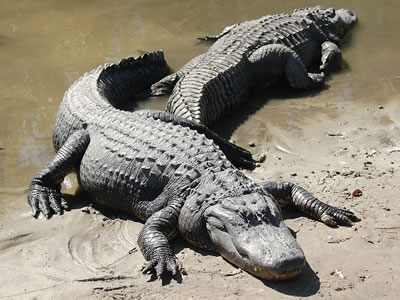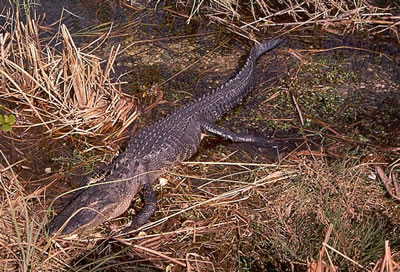Alligators

Facts about creatures
- Home
- Animal Classification
- Animal Habitats
- Amphibians
- Arthropods
- Bats
- Birds
- Carnivorans
- Cetaceans
- Chordates
- Crustaceans
- Dinosaurs
- Diprotodonts
- Elephants
- Fish
- Golden Mole
- Insects
- Lagomorphs
- Mammals
- Mammal Teeth
- Marsupial Mole
- Metamorphosis
- Mollusks
- Primates
- Reptiles
- Rodents
- Ruminants
- Soricomorphans
- Tenrec
- Tetrapods
- Vertebrates
Alligators
Alligators are crocodilians that, along with caimans, make up the family Alligatoridae.
The name “alligator” comes from the Spanish phrase “el lagarto” – “the lizard”.
There are two species of alligator alive today: the American alligator (Alligator mississippiensis), which lives in the southeastern United States and the Chinese alligator (Alligator sinensis), also known as the Yangtze alligator, which is native to the area around the Yangtze River.

Alligators usually live in freshwater but can sometimes be found in brackish water (water that has contains some salt, but is not as salty as seawater).
An alligator has a long, blunt, U-shaped snout. Its snout differs from the snout of a crocodile, which is narrower and V-shaped.
The upper jaw of an alligator is wide than its lower jaw. When the alligator closes its mouth, the teeth in the lower jaw fit inside sockets in the upper jaw, so that the lower teeth cannot be seen.
This jaw structure differs from that of a crocodile. A crocodile has upper and lower jaws of equal width, so that both the upper and lower teeth can be seen when its mouth is shut.
Alligators are opportunistic predators – they will eat whatever is available – and usually hunt at night.
American Alligator
American alligators, or gators, have olive brown, gray or black scales on their backs. Their bellies are white.
They usually weigh between 450 and 600 pounds.
Males are usually between 11 and 15 feet long, while females usually range from 8 to 10 feet long.
American alligators often live in swamps, but they can also be found in rivers, lakes and ponds.
They dig burrows, which they use for shelter. In the winter, they hibernate in their burrows.
During times of drought American alligators sometimes dig alligator holes, or gator holes with their tails. These holes become filled with water and attract other animals, such as wading birds.
Large American alligators are solitary, while small American alligators live together in groups.
They use a variety of calls to communicate with each other.
American alligators were once endangered, but their population has increased since laws protecting them have been enacted and since the demand for alligator hide and alligator meat has declined.
More than a million American alligators are alive today.
The American alligator is Florida’s official state reptile.
American alligators sometimes attack humans, but they do not do so very often.
Alligators instinctively shy away from humans. If an alligator is fed by human beings, it can lose its fear of humans and associate people with food. This can eventually lead to the alligator attacking people.
Feeding alligators is illegal in some states.
Diet
Adult American alligators eat many different kinds of prey, including fish, birds, snakes, turtles and mammals.
Some may eat very large animals like deer, sheep and cattle, or even smaller alligators.
Like all crocodilians, American alligators do not use their teeth for chewing.
When they eat smaller animals, they will sometime swallow them in one gulp.
An American alligator will kill a larger animal by grabbing it between its jaws, dragging it underwater so that it drowns, and then spinning around with it so that chunks of its body are torn off.
This spinning behavior is known as a death roll.
The alligator will swallow each of the chunks whole.
If an American alligator cannot find live prey, it will eat carrion (dead animals whose bodies are decaying).
Young American alligators will eat small invertebrates, such as insects, worms, snails and spiders. They may also eat frogs and small fish.
Breeding
In the spring, a female American alligator will build a nest made of mud, sticks and plant matter, in which she will lay from 20 to 50 eggs.
She will cover the eggs with vegetation to help them to stay warm and watch over the eggs while they are in the nest.
The temperature of the nest determines the sex of the hatchlings – females will hatch from eggs that are kept at lower temperatures, while males will hatch from eggs that are kept at higher temperatures.
If the nest remains below about 86 degrees Fahrenheit (30 degrees Celsius), most hatchlings will be female. If it remains above about 93 degrees Fahrenheit (34 degrees Celsius), most of the offspring will be male.
If the temperature is between the 86 degrees and 93 degrees Fahrenheit, there will be approximately the same number of males as females.
Climate change could have a strong effect on alligator populations as only a small change in temperature could mean that alligators of only one sex would be born, and would therefore not be able to reproduce.
The eggs will hatch after about 60 to 65 days.
When they are about to hatch, young American alligators will make high pitched cries from inside their eggs. The mother will dig the eggs out of the nest when she hears these cries.
She will carry her young to the water, holding them in her mouth.
The hatchlings form a group that is called a pod. They remain close to their mother for about a year.
Despite their mother’s protection, American alligator hatchlings are vulnerable to predators, such as raccoons, birds, large fish and large male alligators. The hatchlings have coloration that helps to camouflage them – they are black with yellow bands.
Chinese Alligators
Chinese alligators live in slow-moving bodies of freshwater, such as rivers, lakes, ponds, swamps and streams.
They have dark green or black scales.
A Chinese alligator is much smaller than an American alligator.
Chinese alligators grow to be only about 6 or 7 feet long and weigh up to about 90 pounds.
The snout of a Chinese alligator turns upward. It is more tapered than the snout of an American alligator.

A Chinese alligator has bony scales protecting its belly and a bony plate on each of its upper eyelids. An American alligator does not have protective scales on its belly or plates on its eyelids.
The diet of a Chinese alligator mostly consists of mollusks with hard shells, such as snails and mussels. It has teeth that are adapted for crushing shells.
Chinese alligators will also eat fish and any other prey that they can find, such as ducks or rats.
In the winter, Chinese alligators hibernate in burrows.
Chinese alligators build nests made out of mounds of vegetation in July and August.
These nests are smaller than the nests constructed by American alligators.
A female Chinese alligator will lay from 10 to 50 eggs.
The eggs will hatch after about 70 days, as long as the temperature is about 86 degrees Fahrenheit (30 degrees Celsius).
Hatchlings are black with yellow bands, like American alligator hatchlings. Young Chinese alligators have fewer bands than young American alligators.
The Chinese alligator is a critically endangered species. There are believed to be less than 150 Chinese alligators in the wild. There are more than 10,000 Chinese alligators in zoos – many more than there are in the wild.
The habitat of the Chinese alligator is being destroyed as wetlands are converted to farmland.
Chinese alligators sometimes come into conflict with farmers because they eat domesticated ducks and destroy irrigation systems.
These alligators sometimes die when they eat rats that have been poisoned.